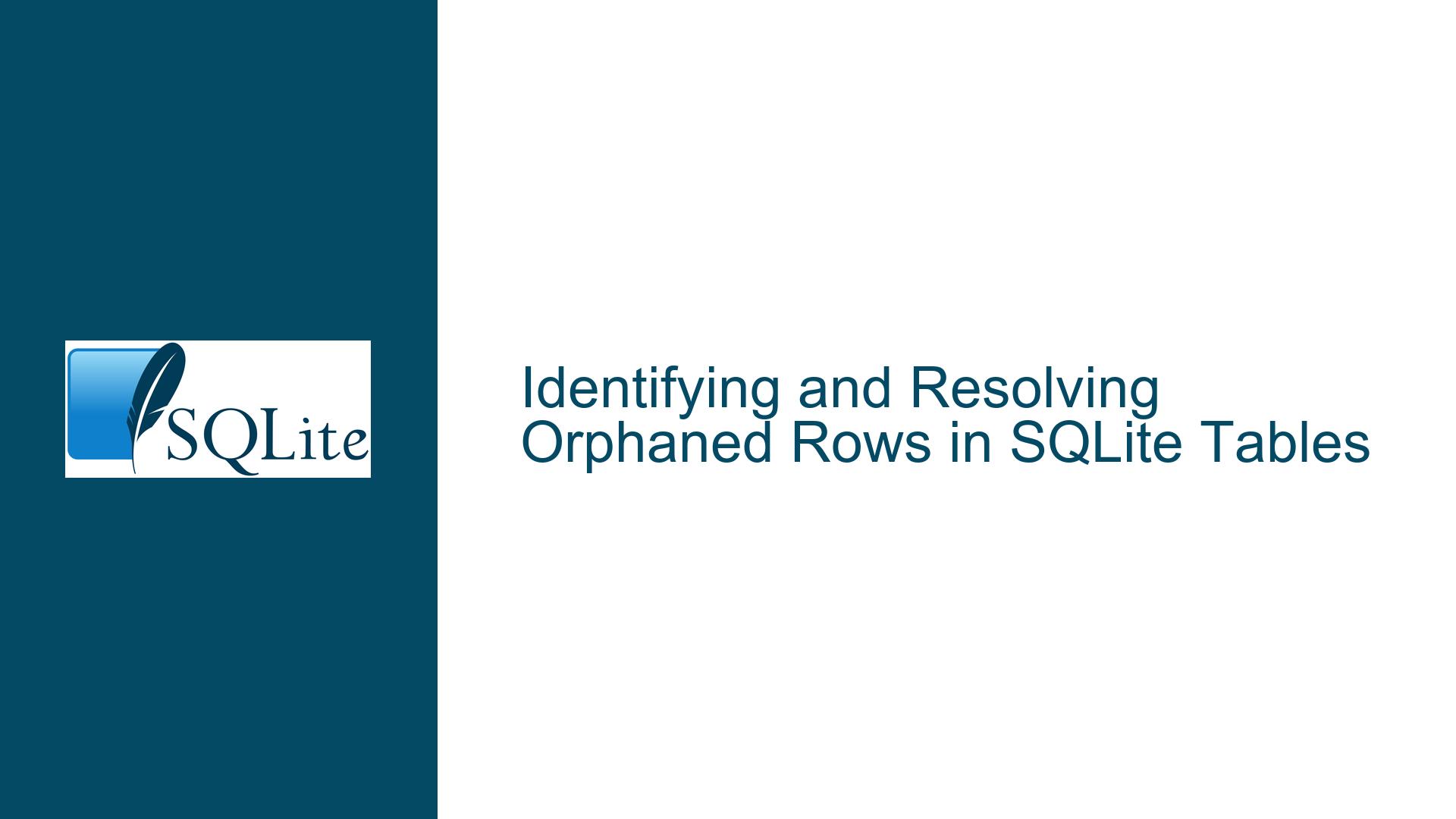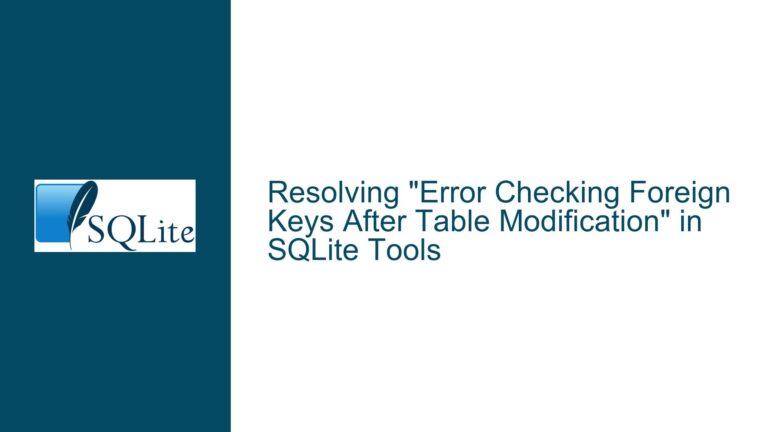Identifying and Resolving Orphaned Rows in SQLite Tables
Understanding Orphaned Rows in the Content Table
The core issue revolves around identifying and resolving orphaned rows in the content table, which reference non-existent rows in the users table. This situation arises when rows in the users table are deleted, but the corresponding created_by references in the content table are not updated or removed. As a result, queries that join these tables based on the created_by field fail to return complete results, as they ignore rows in the content table that reference missing users.
The content table is structured to store articles or posts, with each row containing an id, title, fulltext, created timestamp, and a created_by field that references the id of a user in the users table. The users table, on the other hand, stores user information, including an id and a name. The relationship between these tables is implicit, meaning there are no formal foreign key constraints or referential integrity mechanisms in place to enforce the validity of the created_by references.
When rows in the users table are deleted, the created_by field in the content table may still contain references to the deleted users. These references are now invalid, as they point to non-existent rows in the users table. Consequently, queries that join the content and users tables based on the created_by field will exclude rows in the content table that reference deleted users. This exclusion occurs because the join condition fails for these rows, resulting in incomplete query results.
To address this issue, it is necessary to identify the orphaned rows in the content table—those rows where the created_by field references a non-existent user. Once identified, these rows can be updated to reflect an "unknown author" or handled in a manner appropriate to the application’s requirements. Additionally, implementing referential integrity constraints can prevent this issue from recurring in the future.
Causes of Orphaned Rows in the Content Table
The presence of orphaned rows in the content table can be attributed to several factors, primarily stemming from the absence of referential integrity constraints and proper data management practices. Understanding these causes is essential for both resolving the current issue and preventing its recurrence.
One of the primary causes is the lack of foreign key constraints between the content and users tables. In a well-designed relational database, foreign key constraints enforce referential integrity by ensuring that a value in one table (in this case, the created_by field in the content table) must match a value in another table (the id field in the users table). Without such constraints, it is possible to delete rows in the users table without updating or removing the corresponding references in the content table, leading to orphaned rows.
Another contributing factor is the absence of cascading delete operations. When foreign key constraints are in place, they can be configured to automatically delete or update related rows in other tables when a row in the referenced table is deleted. For example, if a user is deleted from the users table, a cascading delete operation could automatically remove all rows in the content table that reference the deleted user. Without cascading delete operations, the responsibility for maintaining referential integrity falls entirely on the application or database administrator, increasing the likelihood of orphaned rows.
Additionally, the issue may be exacerbated by inadequate data validation and error handling in the application layer. If the application does not validate the existence of referenced users before inserting or updating rows in the content table, it may inadvertently create references to non-existent users. Similarly, if the application does not handle errors related to invalid references gracefully, it may fail to detect and address orphaned rows in a timely manner.
Finally, the issue may arise from manual data manipulation or migration processes. During data migration or bulk data operations, it is possible to introduce inconsistencies between related tables if proper checks and validations are not performed. For example, if rows are deleted from the users table as part of a data cleanup process without updating the content table, orphaned rows may result.
Resolving Orphaned Rows and Preventing Future Issues
To resolve the issue of orphaned rows in the content table, a multi-step approach is recommended. This approach involves identifying the orphaned rows, updating them to reflect an "unknown author," and implementing measures to prevent the issue from recurring.
The first step is to identify the orphaned rows in the content table. This can be achieved using a query that selects rows from the content table where the created_by field does not match any id in the users table. One effective method is to use a LEFT JOIN between the content and users tables and filter for rows where the users.id field is NULL. This approach ensures that only rows in the content table that do not have a corresponding row in the users table are selected. The query would look like this:
SELECT content.id, content.created_by
FROM content
LEFT JOIN users ON content.created_by = users.id
WHERE users.id IS NULL;
Alternatively, a NOT IN subquery can be used to achieve the same result:
SELECT created_by
FROM content
WHERE created_by NOT IN (SELECT id FROM users)
GROUP BY created_by;
Once the orphaned rows have been identified, the next step is to update them to reflect an "unknown author." This can be done by setting the created_by field to a predefined value, such as "unknown" or a specific user ID reserved for this purpose. The update query would look like this:
UPDATE content
SET created_by = 'unknown'
WHERE created_by NOT IN (SELECT id FROM users);
After resolving the orphaned rows, it is crucial to implement measures to prevent the issue from recurring. The most effective measure is to enforce referential integrity constraints between the content and users tables. This can be achieved by adding a foreign key constraint to the content table that references the id field in the users table. The foreign key constraint should be configured to cascade deletes, ensuring that when a user is deleted from the users table, all related rows in the content table are also deleted. The schema modification would look like this:
CREATE TABLE IF NOT EXISTS "users" (
"id" TEXT PRIMARY KEY,
"name" TEXT
);
CREATE TABLE IF NOT EXISTS "content" (
"id" TEXT,
"title" TEXT,
"fulltext" TEXT,
"created" TEXT,
"created_by" TEXT,
FOREIGN KEY (created_by) REFERENCES users(id) ON DELETE CASCADE
);
In addition to enforcing referential integrity, it is advisable to implement data validation and error handling in the application layer. The application should validate the existence of referenced users before inserting or updating rows in the content table. If a referenced user does not exist, the application should handle the error gracefully, either by rejecting the operation or by providing a fallback mechanism, such as assigning an "unknown author."
Finally, regular database maintenance and monitoring can help detect and address orphaned rows before they become a significant issue. This includes periodic checks for orphaned rows, as well as monitoring for changes in the users table that may affect the content table. Automated scripts or database triggers can be used to perform these checks and take corrective actions as needed.
By following these steps, the issue of orphaned rows in the content table can be effectively resolved, and future occurrences can be prevented, ensuring the integrity and reliability of the database.






